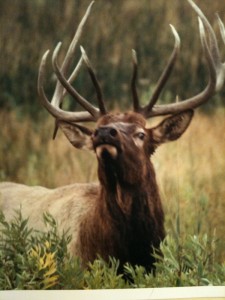How close is too close? This pissed off elk is too close. But when you go where the birds are, you’re gonna see other things, too. So watch out.

Too close.
The elk popped up suddenly, and gored the foliage, tossing clumps of earth and weeds over his head.
I grabbed this shot, and moved back.
Another day, a Rufous Hummingbird started buzzing around my shirt. It was too close. Couldn’t use my binoculars on it.
All this closeness got me thinking: what’s too far? When does distance make a bird sighting…not a sighting?
I’ve been reading about military guys who look down on enemy targets from spy satellites.
Their high tech cameras are science fiction that’s come true. They can show license plates, even facial features.
I’m imagining an army guy somewhere who’s also a two-fisted bird watcher. He’s looking at a live satellite feed. Maybe he’s scouting for bad guys, or following a Special Forces team. Tom Clancy stuff.
Then he sees this once-in-a-lifetime bird down there in the war zone. Say, an Abyssinian Roller.
Whoa. Big, exotic, blue and shiny, with a long tail, a first for the guy. Does this rare bird go on his life list? Of course not. It’s been spotted from space.
On that same trip where I almost tripped into a crazed elk, I saw a grizzly. But I was on a mountain; it was in a valley. I borrowed a telescope from a roadside gawker. The bear looked like an ant down there. I don’t count it.
Last year, when my airplane was landing in Florida, I saw a Bald Eagle below us in wetlands near the airport. Sorry, doesn’t count as a sighting. Not from a plane.
Two-fisted bird watching is old-fashioned. I like my two fists to be holding binoculars. I like walking around where the birds are.
You can count a bird sighting only when you’re in the same place as the bird. At the same time. You can’t be looking at it through a high-powered telescope. Or through an airplane window. And not from space.
Can a bird be too close? Well, the Rufous Hummingbird didn’t work out great. But close birds are rarely a problem.
A close elk could be a problem. But that’s all part of the fun.

Sandy Komito is right about telescopes coming in handy for certain birding experiences. It all comes down to what you’re going for. Different scopes for different folks. By the way, if you’re not familiar with his term, “jizz birding,” it’s a way of identifying birds by the overall impression you get when you see them, at any distance. If you want to Google this, keep the word “birding” in your search term. Thanks to Sandy for a thoughtful comment, and for making the point that birding should be fun.
I love the close/far theme. Matt and I were sitting and watching our cardinal couple come close to our sliding glass window last night and wondered, what makes them so curious about us? So cute and yet still a reflection on the intelligence of animals.
Hmmm. What about peeps in a salt marsh? Sparrow size birds on the other side of tidal pool usually need a SCOPE to spot them. Don’t they count??
You write beautifully but your conclusions on this one are off a bit. Many birders use telescopes. They are merely extensions of their binoculars. There is no one size fits all. 20 power or 30 power binoculars would be impractical in the field unless you had a tripod to keep them steady. 20 or 30 power would also be impractical in the woods. The field would be so small, the light gathering too insufficient and the ability to find the bird in the view most difficult. Birding is not an effort to see how difficult we make things, rather how much fun we can have in being able to solve a tough identifying problem.
To entertain your conclusions would be to only have binoculars and not telescopes. That would eliminate shore birding for sandpipers on vast mud flats, looking for pelagic birds from the shore, trying to identify distant birds by jizz and other advanced techniques, etc. Why not also eliminate the identifying of birds by their sounds? Maybe we shouldn’t even use binoculars and just depend on what we can see without any visual enhancements.
Use of telescopes is what beginning birders should aspire to. I’d rather see you encourage the building of these abilities rather than the limiting of them. Together, they all make birding more fun.
Anyway, keep on writing, I like your style.
Why not count birds from an airplane? If it counts from boats, ships, horses and etc.
Here’s a bird you don’t want a close encounter with – a pheasant exploding up into the air right in front of you. It’s like a feathered missile taking off. Pheasants scare the bejeebers out of my son, and he’s been birding for 19 years.
Barb: Thanks for your Facebook comment, also shown above. Roadside fences count, airplane windows don’t. Zoos don’t count, either. But what if you’re watching Emus in their open-air pen, and a Summer Tanager drops in. He’s behind bars, maybe eating zoo birdfood. A sighting, right? Or is it too man-made?
What if you were in the plane and you saw an eagle flying? Would that count as being in the same place? What about birds that you see perched on roadside fences while you’re driving?